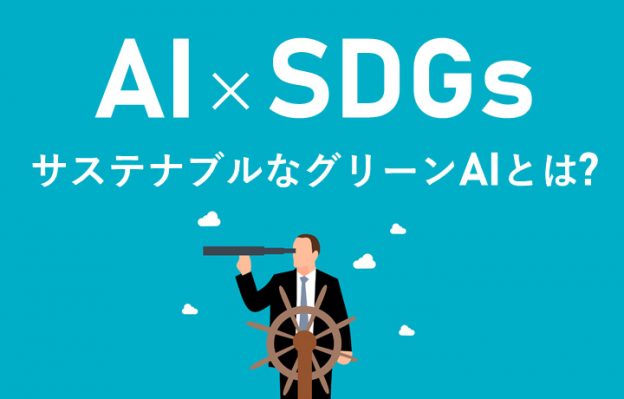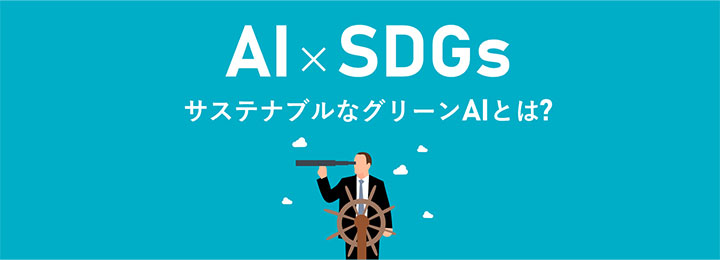
Seven years have passed since the adoption of the SDGs at the United Nations Summit in 2015, and all companies are now required to adopt a comprehensive perspective, including consideration for the environment, in their activities.
This article will introduce examples of using AI to address environmental issues, as well as examine the negative aspects that AI development may bring to the global environment.
We will also explain Green AI, which is gaining attention as a method for sustainable AI development.
- Table of Contents
-
- 1. Initiatives for Environmental Issues Utilizing AI
- 1-1. Case 1: Monitoring Deforestation with Audio Detection
- 1-2. Case 2: Understanding the Ecology of Humpback Whales
- 1-3. Case 3: Reducing Agricultural Water Consumption with AI Weather Forecasting
- 1-4. Case 4: Streamlining Fishing Vessel Operations Schedule to Reduce Fuel Consumption
- 1-5. Case 5: Monitoring Earth's Resources with Satellite Imagery and AI
- 1-6. Automatic Identification of Waste in Incinerators Using AI
- 1-7. AI Traffic Congestion Prediction Model
- 2. The Energy Consumption Issues Caused by AI Development
- 2-1. The Relationship Between AI Development and Environmental Impact
- 2-2. The CO2 emissions associated with AI development are five times that of automobiles
- 2-3. Generative AI and CO2 Emissions
- 3. Sustainable AI Development with Green AI
- 3-1. What is Green AI?
- 3-2. What is Red AI?
- 3-3. Contributing to Carbon Neutrality Just by Using the Cloud
- 4. Consultations on AI Utilization with Human Science
- 4-1. Extensive track record of creating 48 million teacher data entries
- 4-2. Resource Management Without Using Crowdsourcing
- 4-3. Utilizing the latest data annotation tools
- 4-4. Fully equipped security room within the company
1. Initiatives for Environmental Issues Utilizing AI

This section introduces examples of efforts to improve environmental issues using AI.
1-1. Case 1: Monitoring Deforestation with Audio Detection
Rainforest Connection, a non-profit organization in the United States, provides a system to monitor illegal logging by detecting sounds. By setting up smartphones as microphones in forests, the system identifies the sounds of chainsaws and trucks used for transporting timber through AI in the cloud, enabling quicker responses than traditional monitoring systems by utilizing local mobile networks to alert conservation officers.
>>Old smartphones play an active role, listening to the "sounds" of illegal logging
1-2. Case 2: Understanding the Ecology of Humpback Whales
AI technology is being utilized to protect the endangered humpback whale. The AI developed by NOAA (National Oceanic and Atmospheric Administration) and Google can extract specific sounds from environmental noise. This technology has made it possible to isolate and record the calls of humpback whales even in underwater environments filled with various noises. By accurately understanding the timing and areas of humpback whale activity, we are advancing conservation efforts.
1-3. Case 3: Reducing Agricultural Water Consumption with AI Weather Forecasting
The Australian startup The Yield provides high-precision weather forecasting services utilizing AI technology. This service has successfully streamlined farmers' schedules and reduced agricultural water consumption. At the same time, it has led to an increase in crop yields.
The company is also advancing the development of smart agriculture using AI in collaboration with Yamaha Motor in Japan.
>>Yamaha Motor signs joint development agreement with Australian startup for smart agriculture
1-4. Case 4: Streamlining Fishing Vessel Operations Schedule to Reduce Fuel Consumption
The company also offers services specialized in improving production levels for oyster farming. By preventing harvest cancellations and schedule changes due to weather in advance, it contributes not only to increased production but also to the reduction of fuel used for fishing vessel operations by streamlining schedules.
>>Internet of Oysters: The Yield delivers sunnier results for Australian oyster farmers (English)
The University of Tokyo and Sharp Corporation are conducting a demonstration experiment on "smart oyster farming" using AI in Japan.
>>Start of Demonstration Experiment on "Smart Oyster Farming" Utilizing AI/IoT
1-5. Case 5: Monitoring Earth's Resources with Satellite Imagery and AI
The introduction of satellite imagery and AI is effective for monitoring Earth's resources. It is extremely difficult to monitor vast areas solely through human visual observation. By monitoring deforestation, natural gas leaks, and the melting of permafrost in the Arctic based on images from above, we are advancing effective environmental protection activities.
>>From Earth to AI: Three Startups Use Deep Learning to Monitor the Environment
1-6. Case 6: Automatic Identification of Waste in Incinerator Using AI
In "waste incineration power generation," the waste used as raw material originally comes from wood and food sources that absorbed carbon dioxide from the atmosphere. The carbon dioxide generated during incineration is returned to the atmosphere, but in terms of total volume, it is a carbon-neutral power generation method. The challenge of waste incineration power generation is the decrease in energy recovery efficiency due to unstable incineration caused by the uneven mixing of the waste used as fuel. To solve this challenge, stirring was necessary to homogenize the waste, but traditionally it relied on the experience of workers. By introducing AI that identifies waste into the stirring equipment, more efficient stirring can be achieved. Furthermore, by incorporating AI into the combustion control, the energy recovery rate can be further increased.
>>Improving Waste Incineration Power Generation Efficiency with AI
1-7. Case 7: AI Traffic Congestion Prediction Model
It has been found that CO2 emissions during traffic congestion can reach about twice that of normal conditions. By using traffic congestion prediction models, it is possible to reduce CO2 emissions by preventing congestion in advance. Various companies are advancing the development of these prediction models; for example, Geo Technologies Co., Ltd. has successfully developed a model capable of predicting traffic conditions in 5-minute intervals even on regular roads. If utilized effectively, a reduction in CO2 emissions due to avoiding congestion can also be expected.
2. The Energy Consumption Issues Caused by AI Development

From here, we will focus on the negative aspects that AI development brings to the environment.
2-1. The Relationship Between AI Development and Environmental Impact
Behind AI development are processes and methods such as machine learning and deep learning. The environmental impact issues arising from AI development are due to these processes. To achieve higher precision AI, it is necessary to process large amounts of data and perform machine learning. The power consumption for operating a large number of processors and for cooling them increases. If companies that have not previously adopted AI start to do so, their power consumption will increase. As a result, the development and implementation of AI are accompanied by an increase in CO2 emissions.
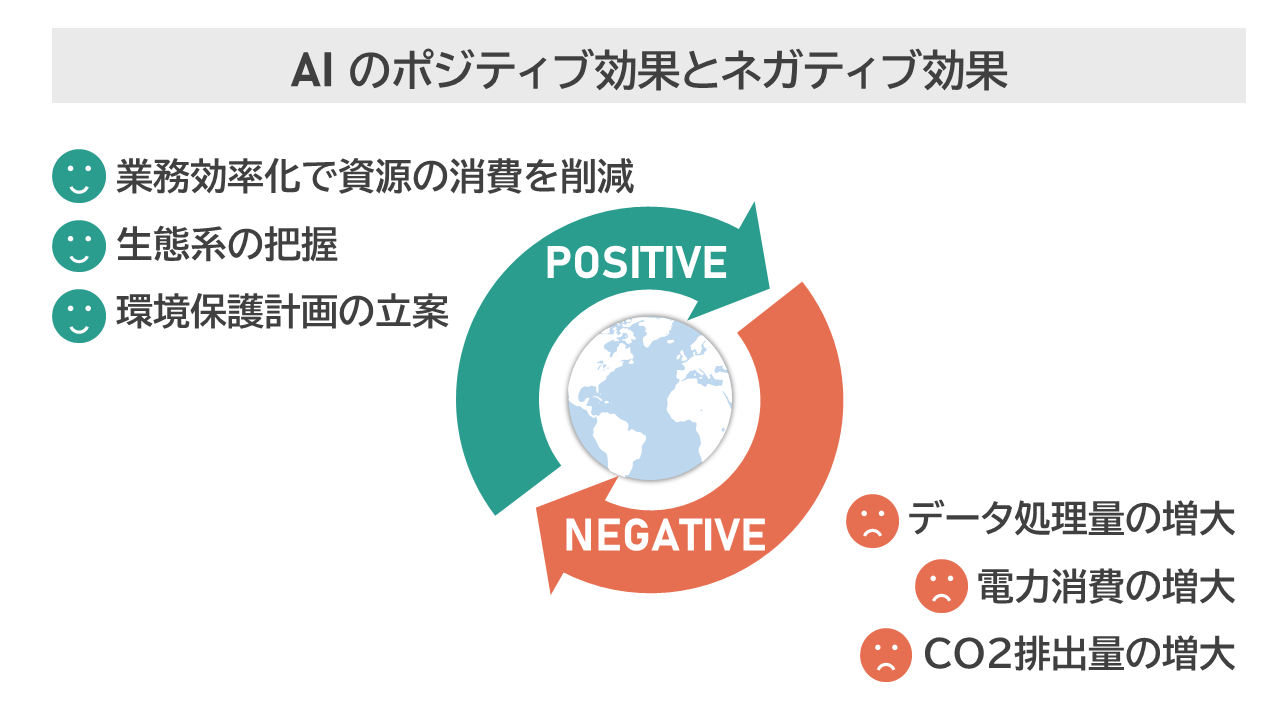
The CO2 emissions associated with AI development are five times that of automobiles.
In 2019, an environmental impact assessment (LCA) was conducted at the University of Massachusetts in the United States regarding a certain AI development. The training of this deep learning model for natural language processing, called Transformer, utilized over 200 million parameters, and the CO2 emissions generated by this process were found to be approximately five times the amount emitted by a car from new to scrapped, and equivalent to 300 times that of a round-trip flight between New York and San Francisco. The increasing energy required for AI development has emerged as a significant challenge that cannot be ignored.
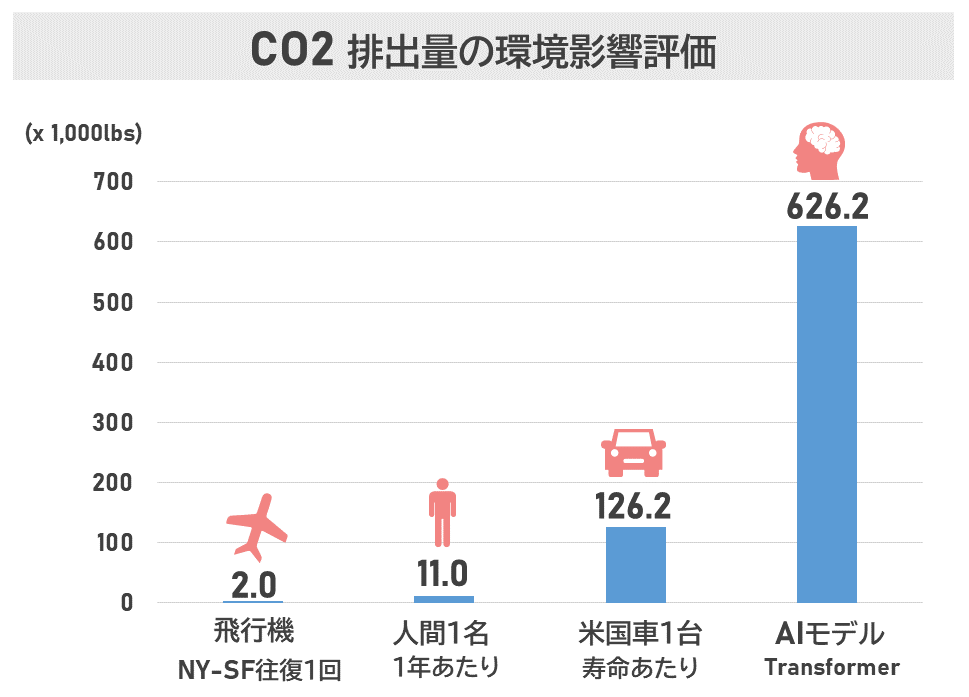
Source: Created by the author from MIT Technology Review 2019 "Training a single AI model can emit as much carbon as five cars in their lifetimes."
2-3. Generative AI and CO2 Emissions
Generative AI, represented by ChatGPT, is spreading explosively. The development of generative AI requires large-scale servers, and a report from Stanford University in the U.S. revealed in April 2023 that the data centers housing them consume massive amounts of electricity.
According to the report, the amount of CO₂ emitted by GPT-3 in one year is 502 tons, which is approximately 507 times the CO₂ emissions per passenger for a round trip flight between New York and San Francisco, which is 0.99 tons.
Additionally, it has been found that the development consumes not only electricity but also large amounts of water for server cooling. It is estimated that when a single user asks GPT-3 between 25 to 50 questions, about one bottle of water is consumed. Thus, as AI advances and becomes more widespread, there is a downside in that the environmental burden increases proportionally.
3. Sustainable AI Development with Green AI
3-1. What is Green AI?
The background of the development of AI is the increasing environmental burden. On the other hand, it is also true that AI is achieving results in addressing environmental issues. Green AI is gaining attention as a method to improve this contradictory situation.
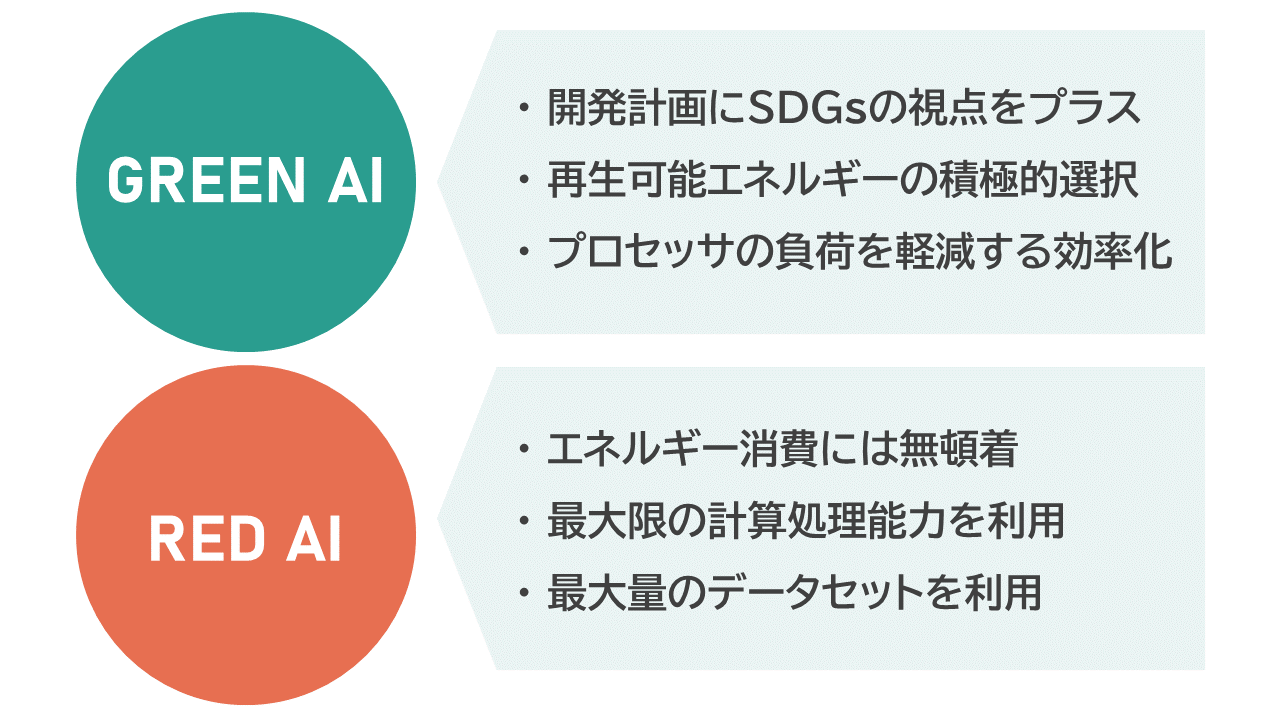
Green AI refers to AI that is developed through research, methods, or practices aimed at operating AI with the utmost energy efficiency. This concept differs from compromising on the quality or accuracy of AI, as it signifies an approach that aims for sustainable AI development from a comprehensive perspective.
Examples of such initiatives include the following.
・Choose a location that is conducive to receiving renewable energy supply when setting up a data center.
・When using public cloud services, select providers that actively utilize renewable energy.
・In AI processing and development, pursue more efficient algorithms to reduce processor load.
3-2. What is Red AI?
In contrast to Green AI, AI development that pursues only accuracy improvement without a comprehensive perspective is called Red AI. It is a method that pours maximum energy into pushing the limits of computer processing power. From the perspective of the SDGs, a review before operation is required.
3-3. Contributing to Carbon Neutrality Just by Using the Cloud
Public cloud data centers have already announced their operational policies for power supply using renewable energy and waste reduction. Choosing these data centers directly contributes to the achievement of the SDGs.
Microsoft has announced that by utilizing its Azure data centers, it can reduce carbon emissions by up to 98% compared to on-premises operations.
>>Microsoft to provide a data platform related to CO2 emissions in the first half of the year
Domestic companies are also setting specific goals towards achieving carbon neutrality in their data centers.
>>No Time to Wait: Data Center Decarbonization
In future AI development, consideration for SDGs in the development process is required, not just the functionality and accuracy of the products being released. To balance the advancement of AI with the achievement of SDGs, let's start with what we can do, such as reviewing work efficiency and selecting data centers.
4. Consultations on AI Utilization with Human Science
4-1. A rich track record of creating 48 million pieces of training data
At Human Science, we participate in AI model development projects across various industries, including natural language processing, medical support, automotive, IT, manufacturing, and construction. To date, we have provided over 48 million high-quality training data through direct transactions with many companies, including GAFAM. We handle a wide range of annotation projects, from small-scale projects to long-term large-scale projects with 150 annotators, regardless of the industry. Companies that want to implement AI models but are unsure where to start are encouraged to consult with us.
>>Human Science's Annotation Services4-2. Resource Management Without Using Crowdsourcing
At Human Science, we do not use crowdsourcing. Instead, projects are handled by personnel who are contracted with us directly. Based on a solid understanding of each member's practical experience and their evaluations from previous projects, we form teams that can deliver maximum performance.
4-3. Utilizing the latest data annotation tools
One of the annotation tools introduced by Human Science, AnnoFab, allows customers to receive progress checks and feedback from the cloud even during the project. By ensuring that work data cannot be saved on local machines, we also take security into consideration.
4-4. Fully equipped security room within the company
Human Science has a security room that meets ISMS standards within our Shinjuku office. We can handle even highly confidential projects on-site. We consider the assurance of confidentiality to be extremely important for any project. Our staff undergoes continuous security training, and we exercise the utmost care in handling information and data, even for remote projects.

 Text Annotation
Text Annotation Audio Annotation
Audio Annotation Image & Video Annotation
Image & Video Annotation Generative AI, LLM, RAG Data Structuring
Generative AI, LLM, RAG Data Structuring
 AI Model Development
AI Model Development In-House Support
In-House Support For the medical industry
For the medical industry For the automotive industry
For the automotive industry For the IT industry
For the IT industry